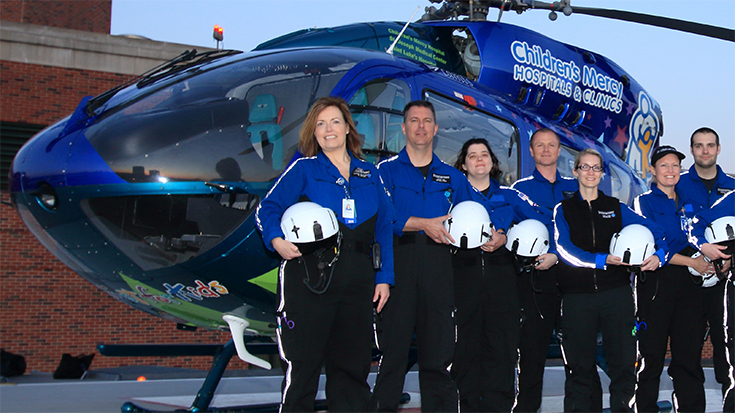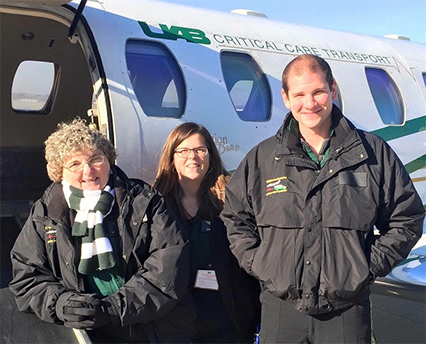
The transport environment in the respiratory care profession is fast-paced and quick-thinking. It’s often just the RT, a nurse, and sometimes a physician, trying to navigate around an exceptionally cramped space while caring for a critically ill patient.
AARC members who work in this adrenaline-pumped setting will tell you it takes more than what you learned in school. And they’ve proven they have the right stuff.
Fast-paced job
Andrew Young, RRT, EMT, has been a transport RT for University of Alabama Critical Care Transport for about three years now and says the job never ceases to be exciting.
“I just love the thrill of getting someone to a higher level of care, knowing they will receive quality treatment,” Young said.

Young, who had past experience as an EMT before taking on the transport RT role, emphasizes the fast-paced nature of the job, noting that critical care transport teams, like the one he is on, are often required to swoop in to pick up a patient from a facility that can’t provide the level of care the patient needs.
“We only care for these patients a minimal amount of time,” Young said. “We can only do so much between the time we pick a patient up and the time we get them to the receiving facility.”
According to Young, delivering care in that setting can be “taxing on the nerves,” but getting them to the best possible status before turning them over to the receiving facility is rewarding.
Emotional rollercoaster
Scott May, RRT-NPS, C-NPT, the transport RT at Children’s Mercy Critical Care Transport in Kansas City, MO, says patients and families are what drew him into the transport setting.
“To provide the patient with a mobile critical care transport team to help facilitate patient care, improve clinical outcomes, and transfer the patient safely to the level of care required is gratifying,” May said.
He’s been working in the transport setting for 20 years now and admits it has been an emotional rollercoaster at times.
But having the chance to make a difference in a patient and family’s life, whether that be rejoicing with them when things go well or consoling them when things do not has been well worth it.
Against all odds
May cites one recent example.
A newborn had developed a pulmonary hemorrhage. While the team worked to stabilize the baby, the child’s father hovered nearby.
“I spoke to him as the team worked, knowing he wanted to hear the words, ‘your baby will be ok,’” May said.
Given the baby’s condition, May couldn’t reassure him with those words.
The team placed the child into the isolette on HFV and multiple drips, and cooling was initiated for neurological protection. But the infant continued to hemorrhage from the pulmonary system and the prognosis was grim.
When they arrived at the hospital, the team stopped by the mother’s room, where she was recovering from an emergency C-section due to a ruptured uterus. She reached for her baby but the child was whisked away to the ICU.
Care was continued, but according to May, the outlook was dreadful and seeing the family in so much pain made it hard for the transport team to maintain their composure.
One week later they followed up with the patient in the ICU. Mom was holding the baby, who was now on a nasal cannula. All imaging for neurological insults were negative and no neurological insults were noted.
“This is my motivation to continue working as a critical care transport RT,” May said.
Integral team members
Both Young and May firmly believe RTs can and should be integral members of the transport team.
“We are professionals in our field and bring a different point of view and way of thinking to the table,” Young said. “We know more about mechanical ventilation and the physiology behind that, and that is a huge thing when it comes to certain types of patients.”
May says RT skills like advanced airway management, airway adjuncts, hemodynamics of the heart and pulmonary system, advanced cardiopulmonary monitoring, x-ray evaluation, blood gas interruption, pulmonary protective ventilation, and cardiopulmonary pharmacology are crucial in the transport environment.
“RTs can provide an enhanced knowledge of critical care treatment modalities for respiratory medicine, cardiopulmonary pathophysiology, and the utilization of advanced respiratory equipment to provide optimum care in conjunction with the care of other advanced providers,” May said.
Lifelong memories
Young says his past three years on the transport team have left him with many memories, but the one that really stands out involved a neonatal patient who ended up needing transport multiple times, giving Young a chance to witness the progression in the child’s care
“The family was so appreciative,” Young said. “It’s not often we see outcomes of patients, let alone to see them in a better state of health.”
He says memories of this patient will stay with him throughout his career.